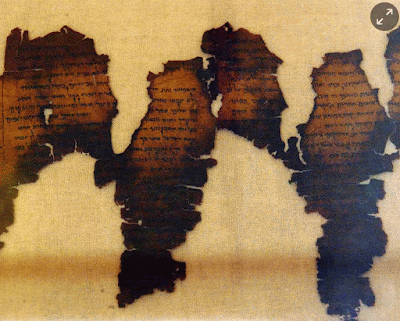The first of the ancient scrolls were discovered in the caves of Qumran in the Judean desert by Bedouin shepherds in the mid-20th century. The manuscripts range from legal documents to parts of the Hebrew Bible, and are thought to date from around the third century BCE to the second century CE.
Now researchers have used artificial intelligence to glean fresh insights into the dates of individual scrolls – findings experts suggest could challenge ideas about when, where and by whom they were produced.
While some scrolls were radiocarbon dated in the 1990s, Popović said scholars did not tackle the problem of castor oil contamination – a substance applied in the 1950s to help experts read the manuscripts, but which could skew results.
In addition, many of the scrolls had only been dated by handwriting analysis.
Writing in the journal Plos One, the team report how they attempted radiocarbon dating of 30 samples from different manuscripts found at four sites and thought to span five centuries. Crucially, the team first cleaned the samples to remove the castor oil contamination.
The researchers successfully radiocarbon-dated 27 samples, finding that while two were younger than handwriting analysis had suggested, many were older.
Among other findings, the researchers discovered two different writing styles, known as Hasmonean and Herodian scripts, coexisted for a much longer period than previously thought, while a sample from a manuscript called 4Q114 – which contains verses from the book of Daniel – was older than traditional palaeography had suggested.
The team then used a type of AI known as machine learning to build a model they called Enoch – a nod to a biblical figure associated with scientific knowledge.
The team trained Enoch by feeding it 62 digital images of ink traces from 24 of the radiocarbon dated manuscripts, together with the carbon-14 dates.
They then verified the model by showing Enoch a further 13 images from the same manuscripts. In 85% of cases the model produced ages that tallied with the radiocarbon dates, and in many cases produced a smaller range of probable dates than obtained from radiocarbon dating alone.
When Enoch was presented with images from 135 undated manuscripts it had not previously seen, it realistically dated 79% of them – as judged by expert palaeographers. Popović added those deemed unrealistic might have had problematic data, such as poor quality images.
The system has already produced new insights including that a copy of the biblical book Ecclesiastes dates from the time of the book’s presumed author.
Popović said Enoch meant the age of further scrolls could now be uncovered without radiocarbon dating – a process that requires the destruction of small samples.
However, Dr Matthew Collins of the University of Chester cautioned that radiocarbon dating only shed light on the age of the parchment, not when it was written on, while there were also questions about how stylistically representative the small number of training samples were for different periods in time.
Source: www.theguardian.com





No comments:
Post a Comment